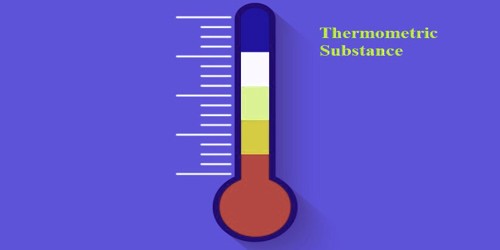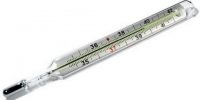Definition: The branch of physics (or heat) relating to the measurement of the temperature of a body is called thermometry. A thermometer is an instrument used to measures the temperature of a body. It can determine the temperature of a body or even of air or atmosphere. It helps in modifiable chemical reactions by controlling temperatures of the solutions.
The physical properties of some substances play an important role in the construction of a thermometer as well as to measure the temperature. The physical properties of the materials which change uniformly with temperature and used for measuring the temperature are called thermometric properties and the materials used for making thermometers are called thermometric substances.
For example, in a mercury thermometer, the principle of expansion of mercury with rising in temperature is used. The platinum resistance thermometer is based on the principle of the change in resistance with a change in temperature.
The thermometric substance is the material used in the thermometer, whose property varies with temperature. In order to assemble a thermometer, we use a substance that has some physical property which changes constantly as the temperature changes. Such substance is known as a thermometric substance. Consequently, there are five good thermometric substances which are.
- Mercury and alcohol,
- All gases,
- Platinum,
- Thermocouples,
- Radiant energy.
A substance might be a constituent or compound. Mixtures and solutions are combinations of one or more dissimilar substances. A liquid in glass thermometer uses mercury or alcohol as its thermometric substance. Substances that show a change in temperature can be used as a thermometric material. Its thermometric property is volume and it is used to determine the temperature by allowing the mercury or alcohol to expand or contract in the capillary tube as temperature rises or decreases.
For example, some substances expand on heating, some change their colors, some change their electric resistance, etc. An increase in temperature equals an increase in volume while a decrease in temperature equals a decrease in volume. Nearly all the substances expand on heating. A mercury-in-glass thermometer has a range of -390 C to 3600 C while an alcohol-in-glass thermometer has a range of -1120 C to 780 C. Liquids also expand on heating and is appropriate as thermometric materials. Common thermometers are generally made using some suitable liquid as thermometric material.
Common Thermometric Substance in the thermometer is Liquid-in-glass and Bimetallic strip. Below described in brief –
Liquid-in-glass thermometers: The most familiar liquid-in-glass thermometers make use of mercury or alcohol as a thermometric liquid. These thermometers work on the standard that liquids expand on heating.
Bimetallic strip thermometers: Bimetallic strip thermometers are used in refrigerators for temperature manages. They are also used in thermometer. The thermometer records a graph of temperature. Instead of a pointer, a pen is attached to the bimetallic strip, which records the temperature on a moving chart. The chart of the temperature is called a thermogram.
A good thermometric property of matter should vary:
- Constantly with temperature
- Uniquely over the range of temperature to be calculated
- Its variation should be computable.













